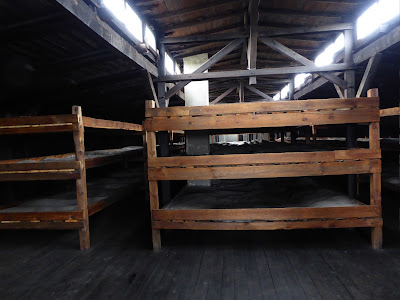It's not often that you get to walk where tens of thousands of men, women, and children died under the order of Nazi leaders. But it's even less common to walk on your very own street and know that that is where many of those Nazis marched by command of Hitler.
Although I am determined to to learn some Polish history outside of the grim details of World War II and the Holocaust, the overwhelming presence of the Nazis in Lublin during WWII deserves a post of its own.
My first encounter with some of this history came unexpectedly on a walk to the bus station. I passed by a large rock monument, to the side of a building and stopped to read the plaque. It commemorated the sad ending of Polish poet Jozef Czechowicz who left Warsaw at the start of the war because he thought his hometown of Lublin a safer option. He died just over a week after the start of the war, when the building where he was getting his hair cut was bombed.
 |
| Monument to a famous resident of Lublin who was killed at the start of WWII |
I've been reading a book about Poland during WWII (
Bloodlands: Europe between Hitler and Stalin by Timothy D. Snyder) and I find myself wondering about the long-term impact of the war on the people of Lublin. Some of the older people who lived during that time are still alive, and thousands of others here have parents and grandparents who were affected by the war. During our recent visit to Lublin's concentration camp, called Majdanek, my ideas were confirmed. Lublin not only lost practically all of it's large Jewish population to the camp or other extermination camps in Europe, but even the residents who were fortunate enough to survive had to deal with Nazis at every corner of the city. As I explained in my previous post, my apartment is very central in Lublin's main district. Apparently, my street has been very central in Lublin for years.
 |
| My home (red star) surrounded by significant Nazi headquarters in the city |
The number 2 on the map shows the location for Lublin District's first forced labor camp for Jews. Today Lublin Plaza (a shopping mall) is located there.
On the same map, just northeast of my home is the Plac Litewski. This park/square is always very busy since almost all the buses pick up and drop off here. I found this plaque at Majdanek Camp:
 |
Left: Nazis marching at "Adolf-Hitler-Platz" (Plac Litewski)
Right: A political protest at Plac Litewski we saw on the way home from Majdanek |
History blows my mind. Ordinary places and people have so much behind them that you just can't comprehend until you go in deeper. Unfortunately, some of that history, like that of the Holocaust, is so dark and painful. Unlike some of the more famous concentration camps, Majdanek doesn't have as many visitors, and especially in the colder months. Besides a few small groups we passed, Alex and I mostly walked this death camp by ourselves. The gray sky and chilly damp barracks seemed fitting for a place of such sadness. It was a very personal experience that I can't explain, but maybe some photos will help.
 |
| Monument built over the original entrance to Majdanek |
 |
| Barrack for the female SS guards |
 |
Left: Control room for gas chamber where "operators" could watch through the window to make sure the gas was working appropriately. Top: gas chamber Bottom: bath house
|
 |
| View from the bath house |
 |
| Shoes confiscated from the prisoners |
 |
The SS guards forced the some prisoners to build this miniature medieval castle for their own entertainment. Supposedly the builders wrote their names on a paper that they buried in the foundation of the castle in a glass vial.
|
 |
| Bunkbeds for 6+ people on each mattress |
 |
The crematorium-today the city has obviously grown, but even back during the war Lublin
residents wrote of seeing smoke rising above the camp |
 |
Eroded and grass-filled remains of the execution ditches. On November 3, 1943
the largest German massacre of Jews in a single day occurred here
as part of Operation "Erntefest" |
 |
| A crematorium furnace |
 |
| Mausoleum containing a mound of ashes of the prisoners |
















Very sobering, Emilae. Thanks for sharing that with us.
ReplyDelete